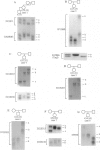Abstract
One t(14q14q), three t(15q15q), two t(21q21q), and two t(22q22q) nonmosaic, apparently balanced, de novo Robertsonian translocation cases were investigated with polymorphic markers to establish the origin of the translocated chromosomes. Four cases had results indicative of an isochromosome: one t(14q14q) case with mild mental retardation and maternal uniparental disomy (UPD) for chromosome 14, one t(15q15q) case with the Prader-Willi syndrome and UPD(15), a phenotypically normal carrier of t(22q22q) with maternal UPD(22), and a phenotypically normal t(21q21q) case of paternal UPD(21). All UPD cases showed complete homozygosity throughout the involved chromosome, which is supportive of a postmeiotic origin. In the remaining four cases, maternal and paternal inheritance of the involved chromosome was found, which unambiguously implies a somatic origin. One t(15q15q) female had a child with a ring chromosome 15, which was also of probable postmeiotic origin as recombination between grandparental haplotypes had occurred prior to ring formation. UPD might be expected to result from de novo Robertsonian translocations of meiotic origin; however, all de novo homologous translocation cases, so far reported, with UPD of chromosomes 14, 15, 21, or 22 have been isochromosomes. These data provide the first direct evidence that nonmosaic Robertsonian translocations, as well as isochromosomes, are commonly the result of a mitotic exchange.
Full text
PDF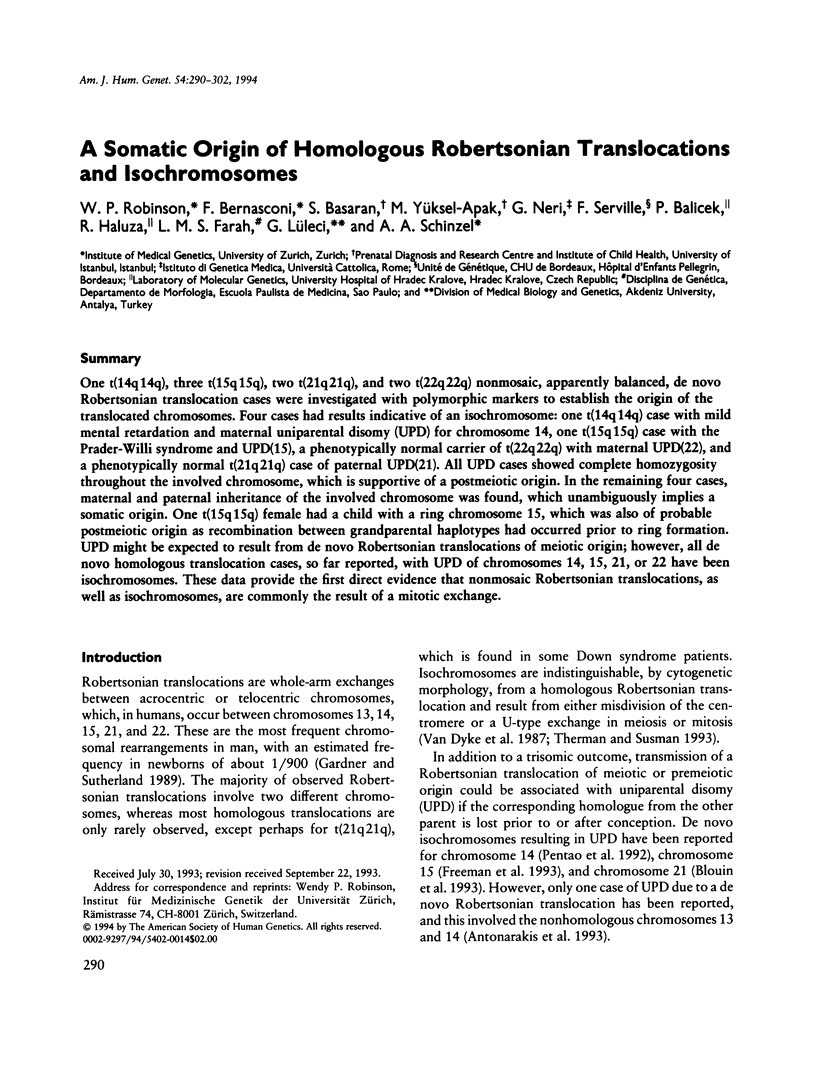
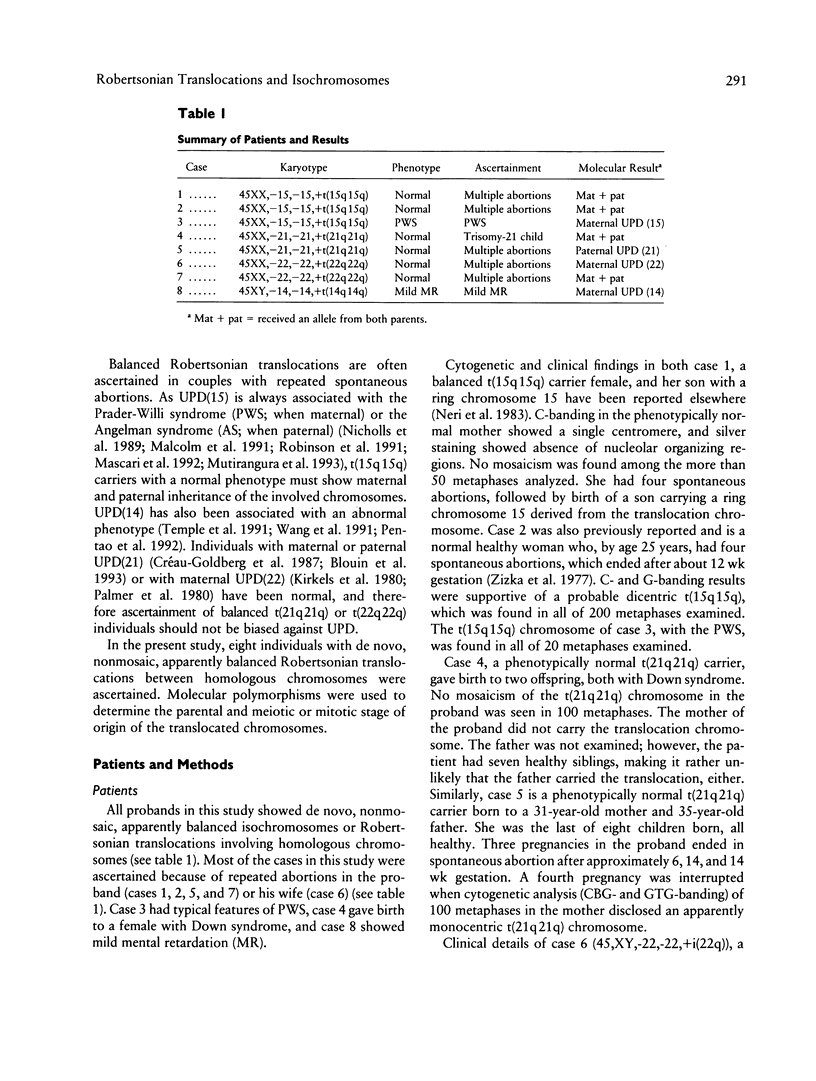
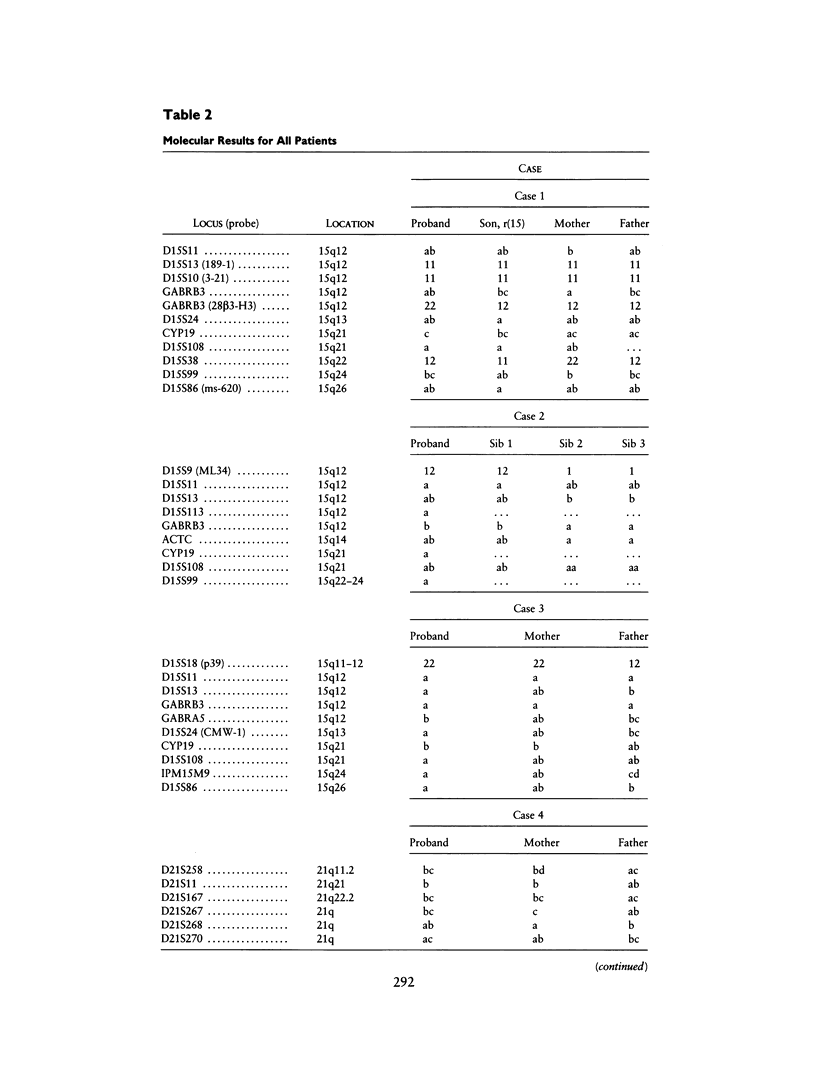
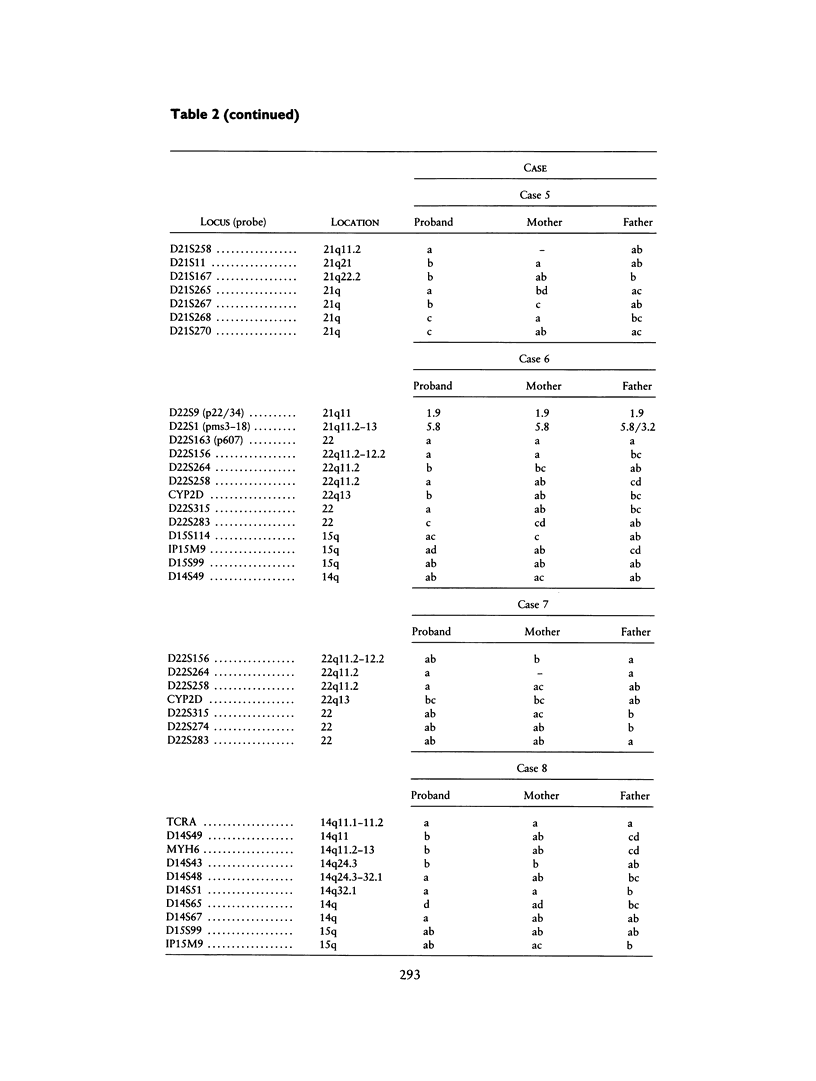

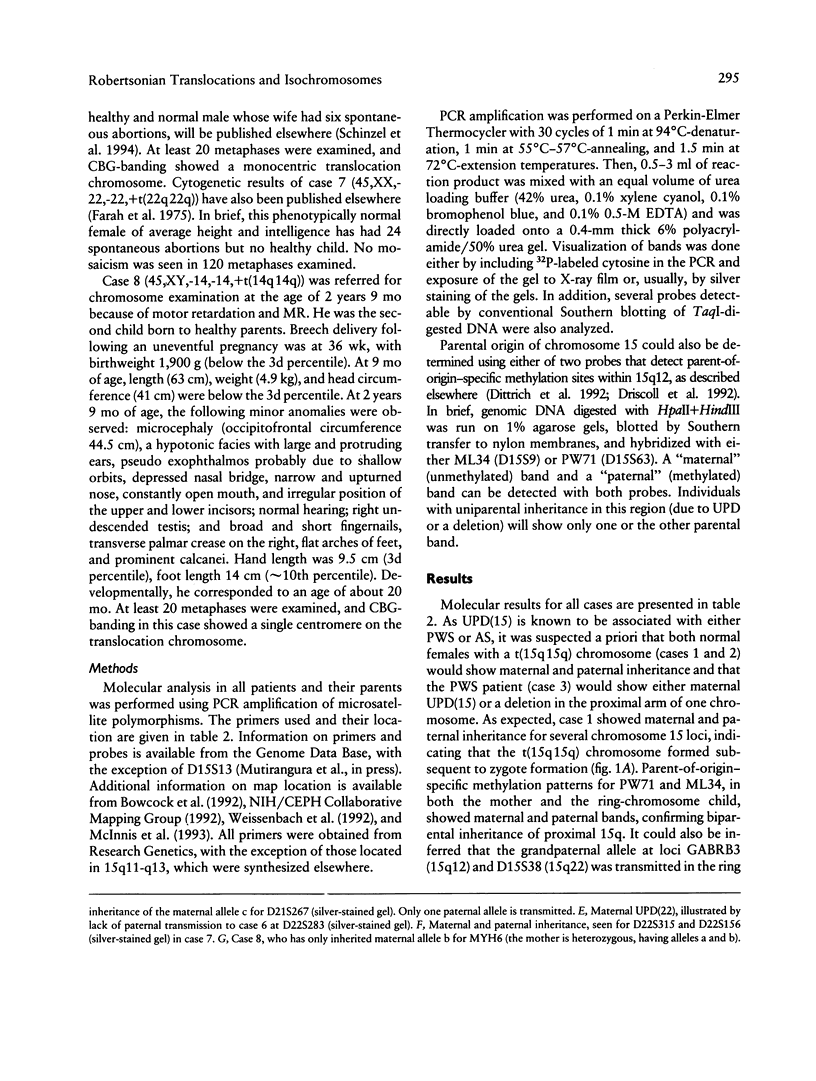

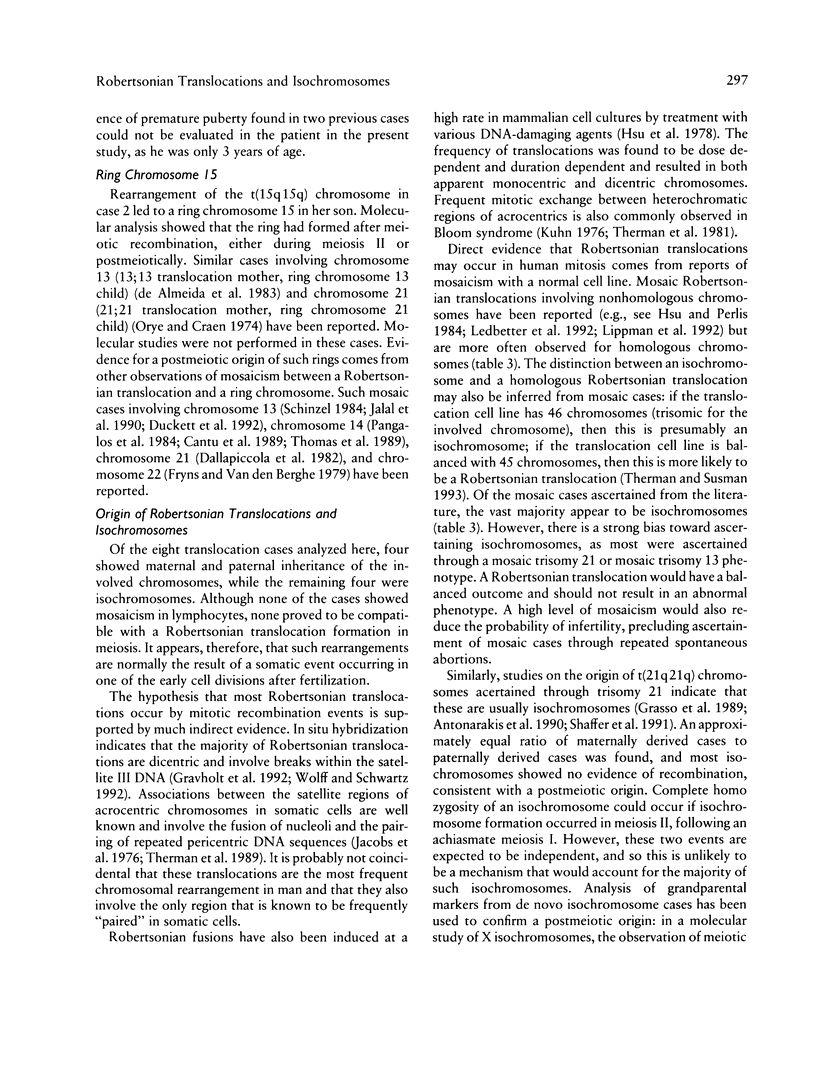
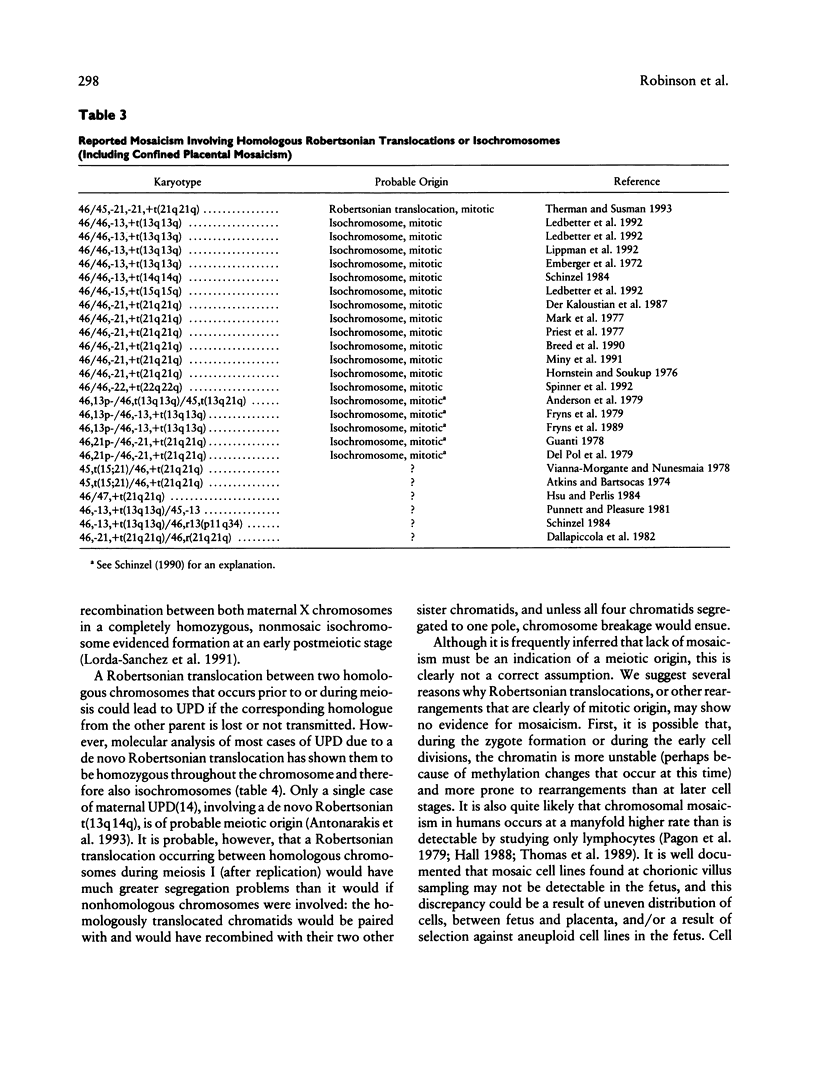
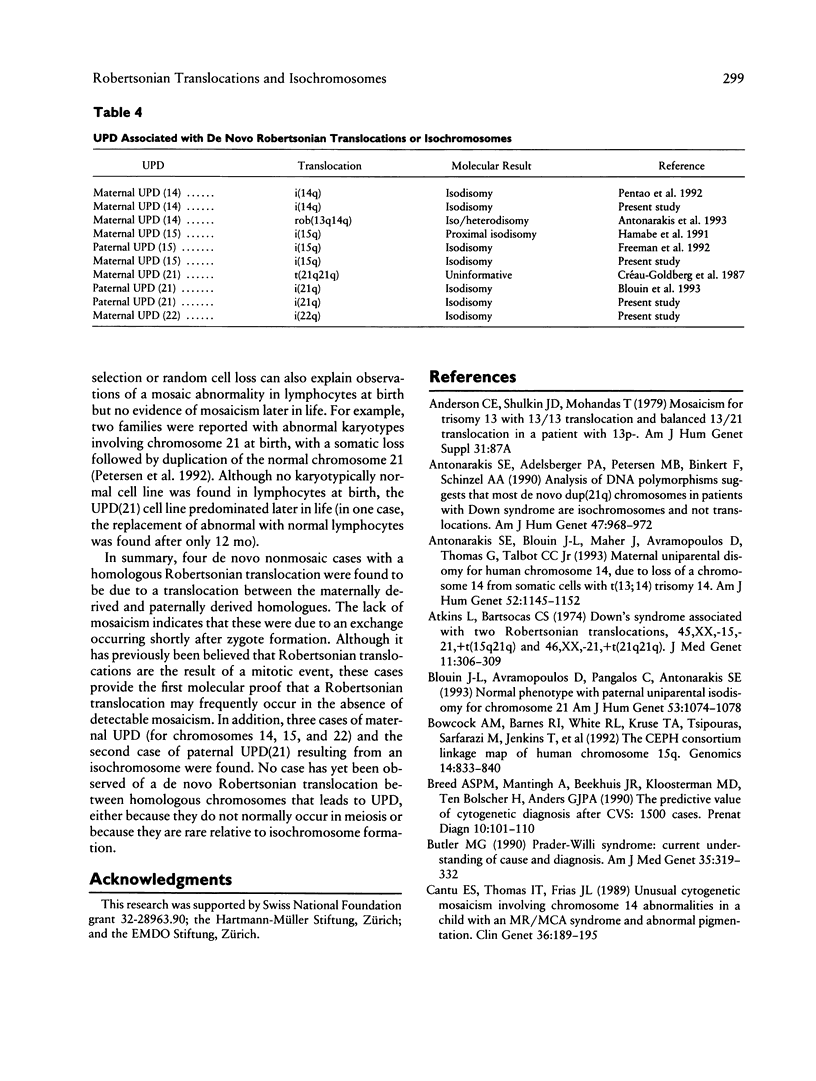
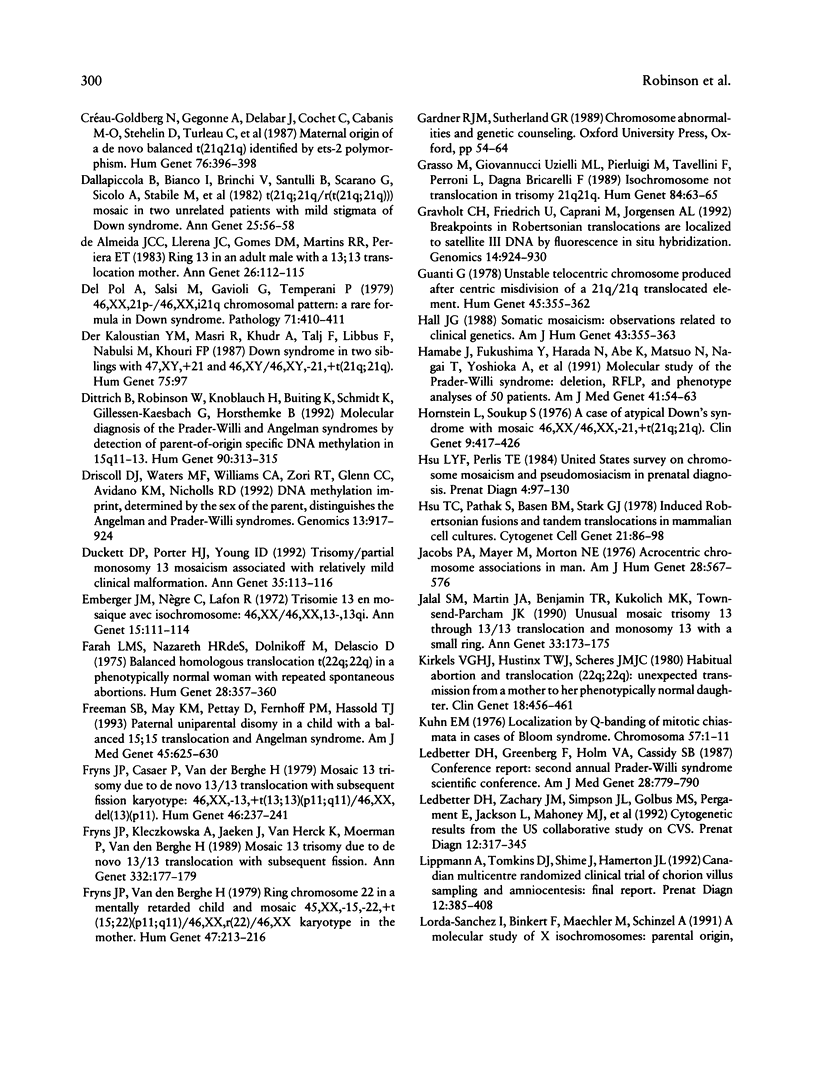
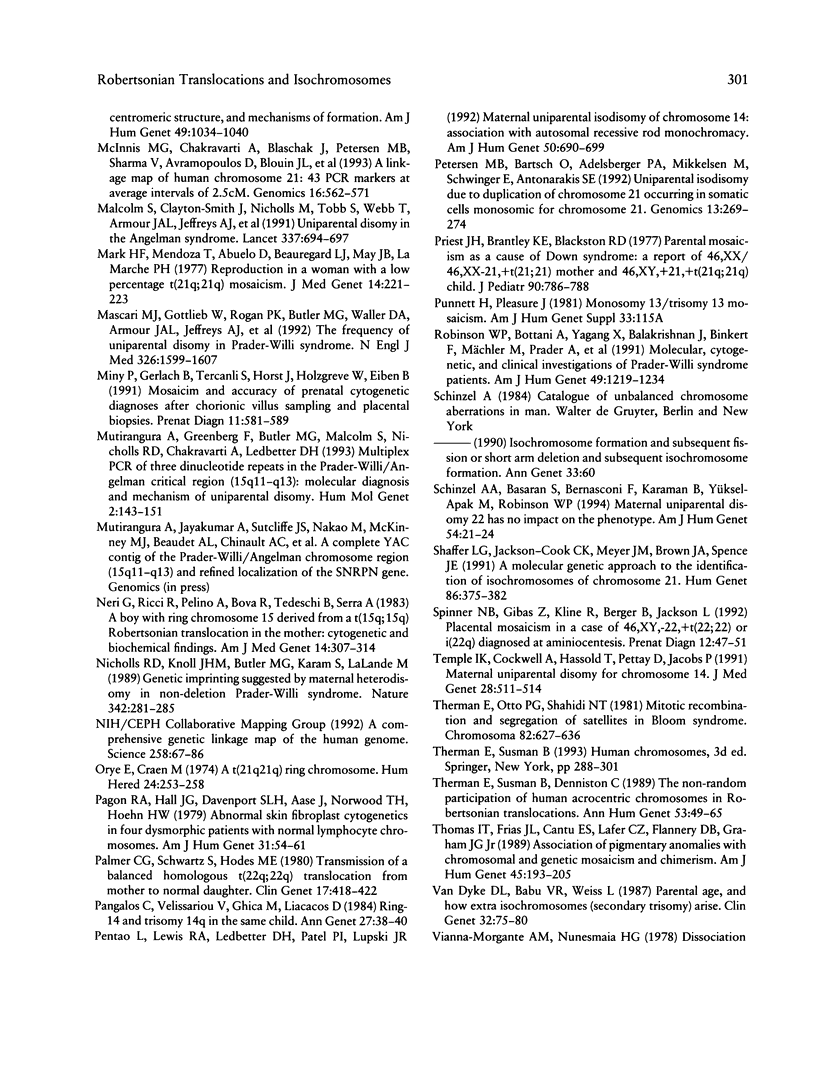
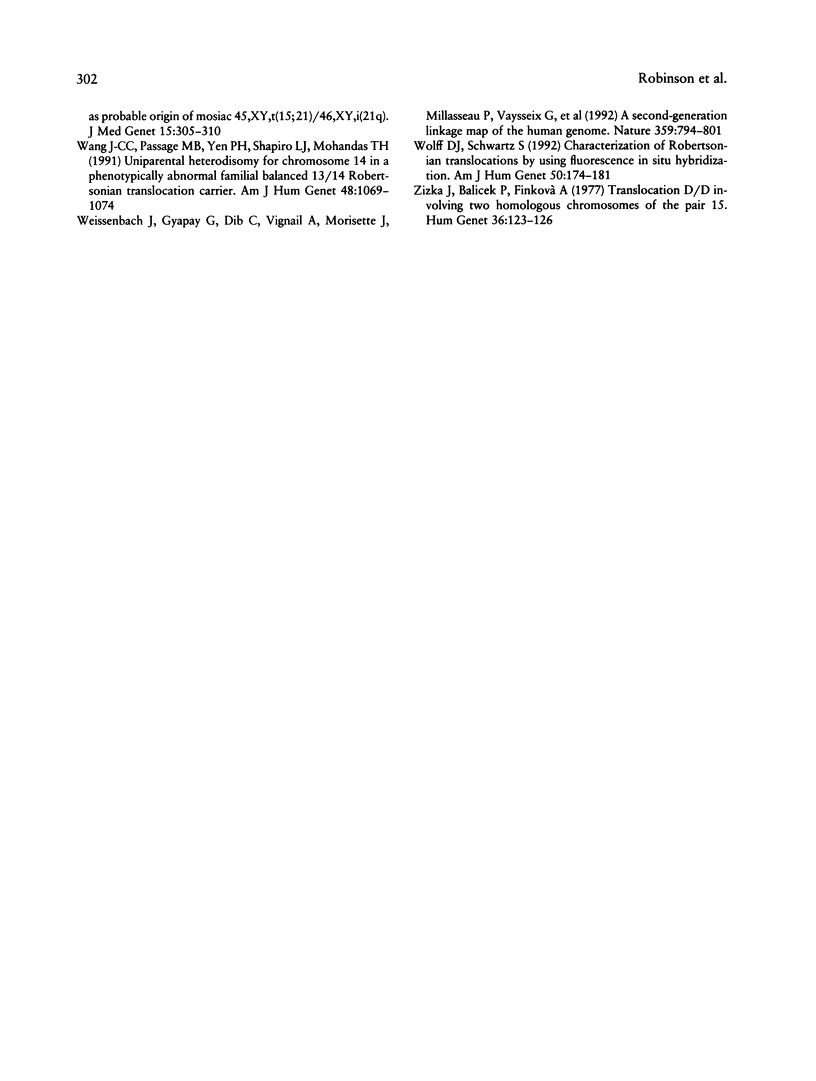
Images in this article
Selected References
These references are in PubMed. This may not be the complete list of references from this article.
- Antonarakis S. E., Adelsberger P. A., Petersen M. B., Binkert F., Schinzel A. A. Analysis of DNA polymorphisms suggests that most de novo dup(21q) chromosomes in patients with Down syndrome are isochromosomes and not translocations. Am J Hum Genet. 1990 Dec;47(6):968–972. [PMC free article] [PubMed] [Google Scholar]
- Antonarakis S. E., Blouin J. L., Maher J., Avramopoulos D., Thomas G., Talbot C. C., Jr Maternal uniparental disomy for human chromosome 14, due to loss of a chromosome 14 from somatic cells with t(13;14) trisomy 14. Am J Hum Genet. 1993 Jun;52(6):1145–1152. [PMC free article] [PubMed] [Google Scholar]
- Atkins L., Bartsocas C. S. Down's syndrome associated with two Robertsonian translocations, 45,XX,-15,-21, + t(15q21q) and 46,XX,-21, + t(21q21q). J Med Genet. 1974 Sep;11(3):306–309. doi: 10.1136/jmg.11.3.306. [DOI] [PMC free article] [PubMed] [Google Scholar]
- Blouin J. L., Avramopoulos D., Pangalos C., Antonarakis S. E. Normal phenotype with paternal uniparental isodisomy for chromosome 21. Am J Hum Genet. 1993 Nov;53(5):1074–1078. [PMC free article] [PubMed] [Google Scholar]
- Bowcock A. M., Barnes R. I., White R. L., Kruse T. A., Tsipouras P., Sarfarazi M., Jenkins T., Viljoen C., Litt M., Kramer P. L. The CEPH consortium linkage map of human chromosome 15q. Genomics. 1992 Dec;14(4):833–840. doi: 10.1016/s0888-7543(05)80101-6. [DOI] [PubMed] [Google Scholar]
- Breed A. S., Mantingh A., Beekhuis J. R., Kloosterman M. D., ten Bolscher H., Anders G. J. The predictive value of cytogenetic diagnosis after CVS: 1500 cases. Prenat Diagn. 1990 Feb;10(2):101–110. doi: 10.1002/pd.1970100206. [DOI] [PubMed] [Google Scholar]
- Butler M. G. Prader-Willi syndrome: current understanding of cause and diagnosis. Am J Med Genet. 1990 Mar;35(3):319–332. doi: 10.1002/ajmg.1320350306. [DOI] [PMC free article] [PubMed] [Google Scholar]
- Cantú E. S., Thomas I. T., Frias J. L. Unusual cytogenetic mosaicism involving chromosome 14 abnormalities in a child with an MR/MCA syndrome and abnormal pigmentation. Clin Genet. 1989 Sep;36(3):189–195. doi: 10.1111/j.1399-0004.1989.tb03187.x. [DOI] [PubMed] [Google Scholar]
- Créau-Goldberg N., Gegonne A., Delabar J., Cochet C., Cabanis M. O., Stehelin D., Turleau C., de Grouchy J. Maternal origin of a de novo balanced t(21q21q) identified by ets-2 polymorphism. Hum Genet. 1987 Aug;76(4):396–398. doi: 10.1007/BF00272452. [DOI] [PubMed] [Google Scholar]
- Dallapiccola B., Bianco I., Brinchi V., Santulli B., Scarano G., Sicolo A., Stabile M., Ventruto V. t(21q21q)/r[t(21q21q)] mosaic in two unrelated patients with mild stigmata of Down's syndrome. Ann Genet. 1982;25(1):56–58. [PubMed] [Google Scholar]
- De Pol A., Salsi M., Gavioli G., Temperani P. Corredo 46,XX21p-/46XX,i(21q): una rara formula nella sindrome di Down. Pathologica. 1979 May-Jun;71(1013):410–411. [PubMed] [Google Scholar]
- Der Kaloustian V. M., Masri R., Khudr A., Talj F., Libbus B., Nabulsi M., Khouri F. P. Down syndrome in two siblings with 47,XY,+21 and 46,XY/46,XY,-21,+t(21q;21q). Hum Genet. 1987 Jan;75(1):97–97. doi: 10.1007/BF00273853. [DOI] [PubMed] [Google Scholar]
- Dittrich B., Robinson W. P., Knoblauch H., Buiting K., Schmidt K., Gillessen-Kaesbach G., Horsthemke B. Molecular diagnosis of the Prader-Willi and Angelman syndromes by detection of parent-of-origin specific DNA methylation in 15q11-13. Hum Genet. 1992 Nov;90(3):313–315. doi: 10.1007/BF00220089. [DOI] [PubMed] [Google Scholar]
- Driscoll D. J., Waters M. F., Williams C. A., Zori R. T., Glenn C. C., Avidano K. M., Nicholls R. D. A DNA methylation imprint, determined by the sex of the parent, distinguishes the Angelman and Prader-Willi syndromes. Genomics. 1992 Aug;13(4):917–924. doi: 10.1016/0888-7543(92)90001-9. [DOI] [PubMed] [Google Scholar]
- Duckett D. P., Porter H. J., Young I. D. Trisomy/partial monosomy 13 mosaicism associated with relatively mild clinical malformation. Ann Genet. 1992;35(2):113–116. [PubMed] [Google Scholar]
- Emberger J. M., Nègre C., Lafon R. Trisomie 13 en mosaique avec isochromosome: 46, XX-46, XX, 13-, 13 qi. Ann Genet. 1972 Jun;15(2):111–114. [PubMed] [Google Scholar]
- Farah L. M., de Nazareth H. R., Dolnikoff M., Delascio D. Balanced homologous translocation t(22q22q) in a phenotypically normal woman with repeated spontaneous abortions. Humangenetik. 1975 Aug 25;28(4):357–360. doi: 10.1007/BF00284812. [DOI] [PubMed] [Google Scholar]
- Freeman S. B., May K. M., Pettay D., Fernhoff P. M., Hassold T. J. Paternal uniparental disomy in a child with a balanced 15;15 translocation and Angelman syndrome. Am J Med Genet. 1993 Mar 1;45(5):625–630. doi: 10.1002/ajmg.1320450522. [DOI] [PubMed] [Google Scholar]
- Fryns J. P., Casaer P., Van den Berghe H. Mosaic 13 trisomy due to de novo 13/13 translocation with subsequent fission. Karyotype: 46,XX, - 13, + t(13;13)(p11;q11)/46,XX,del(13)(p11). Hum Genet. 1979 Jan 25;46(2):237–241. doi: 10.1007/BF00291927. [DOI] [PubMed] [Google Scholar]
- Fryns J. P., Kleczkowska A., Jaeken J., Van Herck K., Van den Berghe M. H. Mosaic 13 trisomy due to de novo 13/13 translocation with subsequent fission. Karyotype: 46,XX,-13, +t(13;13)(p11;q11)/46,XX,del(13)(p11). A second example. Ann Genet. 1989;32(3):177–179. [PubMed] [Google Scholar]
- Fryns J. P., Van den Berghe H. Ring chromosome 22 in a mentally retarded child and mosaic 45,XX,-15,-22,+t(15;22)(p11;q11)/46,XX,r(22)/46,XX karyotype in the mother. Hum Genet. 1979 Mar 12;47(2):213–216. doi: 10.1007/BF00273205. [DOI] [PubMed] [Google Scholar]
- Grasso M., Giovannucci Uzielli M. L., Pierluigi M., Tavellini F., Perroni L., Dagna Bricarelli F. Isochromosome not translocation in trisomy 21q21q. Hum Genet. 1989 Dec;84(1):63–65. doi: 10.1007/BF00210673. [DOI] [PubMed] [Google Scholar]
- Gravholt C. H., Friedrich U., Caprani M., Jørgensen A. L. Breakpoints in Robertsonian translocations are localized to satellite III DNA by fluorescence in situ hybridization. Genomics. 1992 Dec;14(4):924–930. doi: 10.1016/s0888-7543(05)80113-2. [DOI] [PubMed] [Google Scholar]
- Guanti G., Maritato F. Unstable telocentric chromosome produced after centric misdivision of a 21q/21q translocated element. Hum Genet. 1978 Dec 29;45(3):355–362. doi: 10.1007/BF00278735. [DOI] [PubMed] [Google Scholar]
- Hall J. G. Review and hypotheses: somatic mosaicism: observations related to clinical genetics. Am J Hum Genet. 1988 Oct;43(4):355–363. [PMC free article] [PubMed] [Google Scholar]
- Hamabe J., Fukushima Y., Harada N., Abe K., Matsuo N., Nagai T., Yoshioka A., Tonoki H., Tsukino R., Niikawa N. Molecular study of the Prader-Willi syndrome: deletion, RFLP, and phenotype analyses of 50 patients. Am J Med Genet. 1991 Oct 1;41(1):54–63. doi: 10.1002/ajmg.1320410116. [DOI] [PubMed] [Google Scholar]
- Hsu L. Y., Perlis T. E. United States survey on chromosome mosaicism and pseudomosaicism in prenatal diagnosis. Prenat Diagn. 1984 Spring;4(Spec No):97–130. doi: 10.1002/pd.1970040708. [DOI] [PubMed] [Google Scholar]
- Hsu T. C., Pathak S., Basen B. M., Stark G. J. Induced Robertsonian fusions and tandem translocations in mammalian cell cultures. Cytogenet Cell Genet. 1978;21(1-2):86–98. doi: 10.1159/000130881. [DOI] [PubMed] [Google Scholar]
- Jacobs P. A., Mayer M., Morton N. E. Acrocentric chromosome associations in man. Am J Hum Genet. 1976 Nov;28(6):567–576. [PMC free article] [PubMed] [Google Scholar]
- Jalal S. M., Martin J. A., Benjamin T. R., Kukolich M. K., Townsend-Parcham J. K. Unusual mosaic trisomy 13 through 13/13 translocation and monosomy 13 with a small ring. Ann Genet. 1990;33(3):173–175. [PubMed] [Google Scholar]
- Kirkels V. G., Hustinx T. W., Scheres J. M. Habitual abortion and translocation (22q;22q): unexpected transmission from a mother to her phenotypically normal daughter. Clin Genet. 1980 Dec;18(6):456–461. doi: 10.1111/j.1399-0004.1980.tb01794.x. [DOI] [PubMed] [Google Scholar]
- Kuhn E. M. Localization by Q-banding of mitotic chiasmata in cases of Bloom's syndrome. Chromosoma. 1976 Aug 4;57(1):1–11. doi: 10.1007/BF00292945. [DOI] [PubMed] [Google Scholar]
- Ledbetter D. H., Zachary J. M., Simpson J. L., Golbus M. S., Pergament E., Jackson L., Mahoney M. J., Desnick R. J., Schulman J., Copeland K. L. Cytogenetic results from the U.S. Collaborative Study on CVS. Prenat Diagn. 1992 May;12(5):317–345. doi: 10.1002/pd.1970120503. [DOI] [PubMed] [Google Scholar]
- Lippman A., Tomkins D. J., Shime J., Hamerton J. L. Canadian multicentre randomized clinical trial of chorion villus sampling and amniocentesis. Final report. Prenat Diagn. 1992 May;12(5):385–408. doi: 10.1002/pd.1970120508. [DOI] [PubMed] [Google Scholar]
- Lorda-Sanchez I., Binkert F., Maechler M., Schinzel A. A molecular study of X isochromosomes: parental origin, centromeric structure, and mechanisms of formation. Am J Hum Genet. 1991 Nov;49(5):1034–1040. [PMC free article] [PubMed] [Google Scholar]
- Malcolm S., Clayton-Smith J., Nichols M., Robb S., Webb T., Armour J. A., Jeffreys A. J., Pembrey M. E. Uniparental paternal disomy in Angelman's syndrome. Lancet. 1991 Mar 23;337(8743):694–697. doi: 10.1016/0140-6736(91)90278-w. [DOI] [PubMed] [Google Scholar]
- Mark H. F., Mendoza T., Abuelo D., Beauregard L. J., May J. B., LaMarche P. H. Reproduction in a woman with low percentage t(21q21q) mosaicism. J Med Genet. 1977 Jun;14(3):221–223. doi: 10.1136/jmg.14.3.221. [DOI] [PMC free article] [PubMed] [Google Scholar]
- Mascari M. J., Gottlieb W., Rogan P. K., Butler M. G., Waller D. A., Armour J. A., Jeffreys A. J., Ladda R. L., Nicholls R. D. The frequency of uniparental disomy in Prader-Willi syndrome. Implications for molecular diagnosis. N Engl J Med. 1992 Jun 11;326(24):1599–1607. doi: 10.1056/NEJM199206113262404. [DOI] [PMC free article] [PubMed] [Google Scholar]
- McInnis M. G., Chakravarti A., Blaschak J., Petersen M. B., Sharma V., Avramopoulos D., Blouin J. L., König U., Brahe C., Matise T. C. A linkage map of human chromosome 21:43 PCR markers at average intervals of 2.5 cM. Genomics. 1993 Jun;16(3):562–571. doi: 10.1006/geno.1993.1231. [DOI] [PubMed] [Google Scholar]
- Miny P., Hammer P., Gerlach B., Tercanli S., Horst J., Holzgreve W., Eiben B. Mosaicism and accuracy of prenatal cytogenetic diagnoses after chorionic villus sampling and placental biopsies. Prenat Diagn. 1991 Aug;11(8):581–589. doi: 10.1002/pd.1970110815. [DOI] [PubMed] [Google Scholar]
- Mutirangura A., Greenberg F., Butler M. G., Malcolm S., Nicholls R. D., Chakravarti A., Ledbetter D. H. Multiplex PCR of three dinucleotide repeats in the Prader-Willi/Angelman critical region (15q11-q13): molecular diagnosis and mechanism of uniparental disomy. Hum Mol Genet. 1993 Feb;2(2):143–151. doi: 10.1093/hmg/2.2.143. [DOI] [PMC free article] [PubMed] [Google Scholar]
- Neri G., Ricci R., Pelino A., Bova R., Tedeschi B., Serra A. A boy with ring chromosome 15 derived from a t(15q;15q) Robertsonian translocation in the mother: cytogenetic and biochemical findings. Am J Med Genet. 1983 Feb;14(2):307–314. doi: 10.1002/ajmg.1320140211. [DOI] [PubMed] [Google Scholar]
- Nicholls R. D., Knoll J. H., Butler M. G., Karam S., Lalande M. Genetic imprinting suggested by maternal heterodisomy in nondeletion Prader-Willi syndrome. Nature. 1989 Nov 16;342(6247):281–285. doi: 10.1038/342281a0. [DOI] [PMC free article] [PubMed] [Google Scholar]
- Orye E., Craen M. A t(21q21q) ring chromosome. Hum Hered. 1974;24(3):253–258. doi: 10.1159/000152658. [DOI] [PubMed] [Google Scholar]
- Pagon R. A., Hall J. G., Davenport S. L., Aase J., Norwood T. H., Hoehn H. W. Abnormal skin fibroblast cytogenetics in four dysmorphic patients with normal lymphocyte chromosomes. Am J Hum Genet. 1979 Jan;31(1):54–61. [PMC free article] [PubMed] [Google Scholar]
- Palmer C. G., Schwartz S., Hodes M. E. Transmission of a balanced homologous t(22q;22q) translocation from mother to normal daughter. Clin Genet. 1980 Jun;17(6):418–422. doi: 10.1111/j.1399-0004.1980.tb00173.x. [DOI] [PubMed] [Google Scholar]
- Pangalos C., Velissariou V., Ghica M., Liacacos D. Ring-14 and trisomy 14q in the same child. Ann Genet. 1984;27(1):38–40. [PubMed] [Google Scholar]
- Pentao L., Lewis R. A., Ledbetter D. H., Patel P. I., Lupski J. R. Maternal uniparental isodisomy of chromosome 14: association with autosomal recessive rod monochromacy. Am J Hum Genet. 1992 Apr;50(4):690–699. [PMC free article] [PubMed] [Google Scholar]
- Petersen M. B., Bartsch O., Adelsberger P. A., Mikkelsen M., Schwinger E., Antonarakis S. E. Uniparental isodisomy due to duplication of chromosome 21 occurring in somatic cells monosomic for chromosome 21. Genomics. 1992 Jun;13(2):269–274. doi: 10.1016/0888-7543(92)90242-k. [DOI] [PubMed] [Google Scholar]
- Priest J. H., Brantley K. E., Blackston R. D. Parental mosaicism as a cause of Down syndrome. A report of 46,XX/46,XX,--21,+t(21q21q1 mother and 46,XY,+21,+t(21q21q) child. J Pediatr. 1977 May;90(5):786–788. doi: 10.1016/s0022-3476(77)81252-3. [DOI] [PubMed] [Google Scholar]
- Priest J. H., Tishler P. V., Rosner B. Dermatoglyphics in mosaic Down's syndrome. Clin Genet. 1976 Apr;9(4):417–426. doi: 10.1111/j.1399-0004.1976.tb02271.x. [DOI] [PubMed] [Google Scholar]
- Robinson W. P., Bottani A., Xie Y. G., Balakrishman J., Binkert F., Mächler M., Prader A., Schinzel A. Molecular, cytogenetic, and clinical investigations of Prader-Willi syndrome patients. Am J Hum Genet. 1991 Dec;49(6):1219–1234. [PMC free article] [PubMed] [Google Scholar]
- Schinzel A. A., Basaran S., Bernasconi F., Karaman B., Yüksel-Apak M., Robinson W. P. Maternal uniparental disomy 22 has no impact on the phenotype. Am J Hum Genet. 1994 Jan;54(1):21–24. [PMC free article] [PubMed] [Google Scholar]
- Schinzel A. Isochromosome formation and subsequent fission or short arm deletion and subsequent isochromosome formation? Ann Genet. 1990;33(1):60–60. [PubMed] [Google Scholar]
- Second Annual Prader-Willi Syndrome Scientific Conference. Houston, June 17, 1987. Proceedings and abstracts. Am J Med Genet. 1987 Dec;28(4):779–924. doi: 10.1002/ajmg.1320280402. [DOI] [PubMed] [Google Scholar]
- Shaffer L. G., Jackson-Cook C. K., Meyer J. M., Brown J. A., Spence J. E. A molecular genetic approach to the identification of isochromosomes of chromosome 21. Hum Genet. 1991 Feb;86(4):375–382. doi: 10.1007/BF00201838. [DOI] [PubMed] [Google Scholar]
- Spinner N. B., Gibas Z., Kline R., Berger B., Jackson L. Placental mosaicism in a case of 46,XY,-22,+t(22;22)(p11;q11) or i(22q) diagnosed at amniocentesis. Prenat Diagn. 1992 Jan;12(1):47–51. doi: 10.1002/pd.1970120107. [DOI] [PubMed] [Google Scholar]
- Temple I. K., Cockwell A., Hassold T., Pettay D., Jacobs P. Maternal uniparental disomy for chromosome 14. J Med Genet. 1991 Aug;28(8):511–514. doi: 10.1136/jmg.28.8.511. [DOI] [PMC free article] [PubMed] [Google Scholar]
- Therman E., Otto P. G., Shahidi N. T. Mitotic recombination and segregation of satellites in Bloom's syndrome. Chromosoma. 1981;82(5):627–636. doi: 10.1007/BF00285772. [DOI] [PubMed] [Google Scholar]
- Therman E., Susman B., Denniston C. The nonrandom participation of human acrocentric chromosomes in Robertsonian translocations. Ann Hum Genet. 1989 Jan;53(Pt 1):49–65. doi: 10.1111/j.1469-1809.1989.tb01121.x. [DOI] [PubMed] [Google Scholar]
- Thomas I. T., Frias J. L., Cantu E. S., Lafer C. Z., Flannery D. B., Graham J. G., Jr Association of pigmentary anomalies with chromosomal and genetic mosaicism and chimerism. Am J Hum Genet. 1989 Aug;45(2):193–205. [PMC free article] [PubMed] [Google Scholar]
- Van Dyke D. L., Babu V. R., Weiss L. Parental age, and how extra isochromosomes (secondary trisomy) arise. Clin Genet. 1987 Jul;32(1):75–79. doi: 10.1111/j.1399-0004.1987.tb03328.x. [DOI] [PubMed] [Google Scholar]
- Vianna-Morgante A. M., Nunesmaia H. G. Dissociation as probable origin of mosaic 45,XY,t(15;21)/46,XY,i(21q). J Med Genet. 1978 Aug;15(4):305–310. doi: 10.1136/jmg.15.4.305. [DOI] [PMC free article] [PubMed] [Google Scholar]
- Wang J. C., Passage M. B., Yen P. H., Shapiro L. J., Mohandas T. K. Uniparental heterodisomy for chromosome 14 in a phenotypically abnormal familial balanced 13/14 Robertsonian translocation carrier. Am J Hum Genet. 1991 Jun;48(6):1069–1074. [PMC free article] [PubMed] [Google Scholar]
- Weissenbach J., Gyapay G., Dib C., Vignal A., Morissette J., Millasseau P., Vaysseix G., Lathrop M. A second-generation linkage map of the human genome. Nature. 1992 Oct 29;359(6398):794–801. doi: 10.1038/359794a0. [DOI] [PubMed] [Google Scholar]
- Wolff D. J., Schwartz S. Characterization of Robertsonian translocations by using fluorescence in situ hybridization. Am J Hum Genet. 1992 Jan;50(1):174–181. [PMC free article] [PubMed] [Google Scholar]
- Zizka J., Balícek P., Finková A. Translocation D/D involving two homologous chromosomes of the pair 15. Hum Genet. 1977 Apr 7;36(1):123–125. doi: 10.1007/BF00390444. [DOI] [PubMed] [Google Scholar]
- de Almeida J. C., Llerena J. C., Jr, Gomes D. M., Martins R. R., Pereira E. T. Ring 13 in an adult male with a 13:13 translocation mother. Ann Genet. 1983;26(2):112–115. [PubMed] [Google Scholar]



